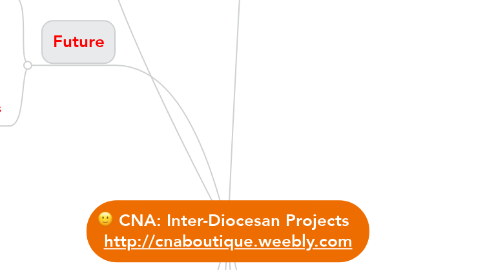
1. INTEL Teach Elements PD
1.1. Collaboration in the Digital Classroom
1.2. Project Based Approaches
1.3. Assessment in 21st Century Classrooms
2. Contacts
2.1. Vickie Vance - CEO Bathurst
2.2. Laurie Wales - CEO Maitland/Newscastle
2.3. Danielle Peters - CEO Ballarat
3. Best practice features
3.1. Offers authentic learning (Chickering and Gamson)
3.1.1. participant and EO contact
3.1.2. active learning
3.1.3. prompt feedback
3.1.4. Time on task
3.1.5. high expectations
3.1.6. values diverse talents and learning styles
3.1.7. reflective practice
3.2. Various tools provided
3.2.1. Web-based
3.2.1.1. access anytime, anywhere
3.2.2. Multimedia
3.2.2.1. voki, text, video tutorials and documents
3.2.3. blog for discussion opportunities
3.2.4. share work online via discussion
3.2.5. active assignment to measure participants progress
4. In the beginning
4.1. CNA
4.1.1. MCL vs DCL led to establishing the "Boutique" group - supporting Education Officers (EO) in smaller dioceses
4.1.2. Space, time and place for EOs to collaborate
4.1.2.1. discovery of common needs and issues
4.2. INTEL
4.2.1. EO at MN and BBD investigate INTEL Teach programs
4.2.2. Rigorous PD Program, well supported by literature and registered with NSW IT
4.2.3. "Australianised"
4.2.3.1. now increasingly adopted eg. NSW DEC
4.2.4. Promotes Contemporary Learning Principles and Practices
4.2.5. Standardised with an ability to customise to suit individual diocese
4.2.6. Courses successfully trialled and then shared with other dioceses
5. Present
5.1. Cybersafety Resources
5.1.1. Parents
5.1.2. Teachers
5.1.3. Students
5.2. Byte-Size Challenges
5.2.1. History
5.2.1.1. Came directly from feedback with the Intel Course
5.2.1.1.1. time limitations of participating teachers
5.2.1.1.2. presumed level of online experiences
5.2.1.2. Involves Bathurst and Ballarat teachers and CEO staff
5.2.2. Planning and updates
5.2.2.1. Website
5.2.2.1.1. Modified in response to participants queries
5.2.2.1.2. Allows legacy - Reference and resource past Challenges
5.2.2.1.3. Uses existing resources from the web
5.2.2.1.4. Demonstrates and models contemporary learning approaches in a small manageable way
5.2.2.2. Communication
5.2.2.2.1. Collaborative Website building by facilitators synchronously and asynchronously
5.2.2.2.2. Meeting online using GoToMeetings
5.2.2.2.3. Emails to participants to announce release of parts of the challenge
5.2.2.3. Accreditation
5.2.2.3.1. recognition of work completed
5.2.3. Evaluation and stats
5.2.3.1. See website for a sample of participants' comments
5.2.4. Design
5.2.4.1. stepped release of information and requirements 3 x 2 hours parts
5.2.4.2. Individual yet an element of collaboration and collegiality through sharing products
5.2.4.3. Participants empowered to complete in their own time schedule - approximately 6 hours over six weeks
6. Future
6.1. Possibilities
6.1.1. Develop an mobile devices investigation course
6.1.2. Develop a Professional Learning Standards course
6.1.3. CNA subscription to Atomic Learning
6.1.4. CNA portal to foster collaboration among dioceses
6.1.5. Directors supporting contemporary learning via CNA projects
6.2. Challenges
6.2.1. Run out of quality Web 2 tools worth promoting
6.2.2. Sustainability and scalability
6.2.3. Be proactive to ensure pedagogy addresses contemporary learning environments
6.2.4. Government drivers asserting higher expectations
